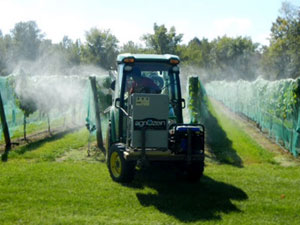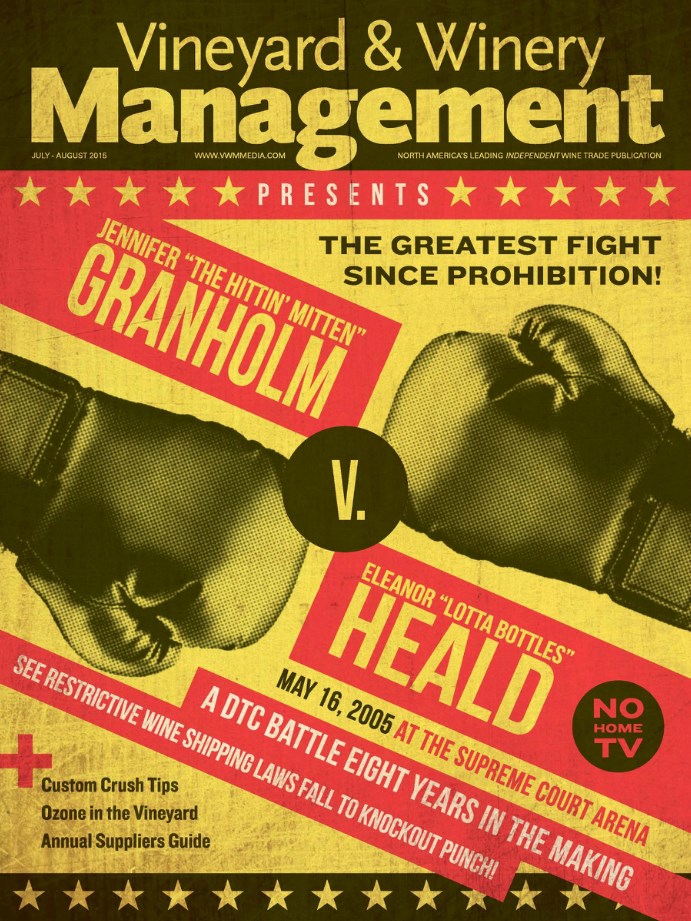Ozonated Water Replaces Chemicals in More Vineyards
February 20, 2014 - Article by Danny Wood - Midwest Wine Press
Ernie Wilmink, owner of AgriOzein, the Nebraska based company that designs and builds ozonators, has come a long way since Midwest Wine Press last spoke with him during early 2013. There’s now growing evidence that the Dutchman’s ozonated water spray for controlling vineyard pests – without the use of chemicals – is having an impact on the wine industry in the United States and overseas.
See related Midwest Wine Press story: Ozonated Water: Vineyard Pest Control Without Chemicals
In the past year, regulatory issues regarding ozone in the U.S. have cleared. In Europe, after Wilmink’s tour of France and Germany, viticulture institutions and winemakers are supporting the technology. New test results from the Midwest and overseas further demonstrate that ozonated water can manage insects and fungus, although research is ongoing, as detailed later in this article.
In the U.S., some viticulture academics are unwilling to accept the technology – or even test it. This reluctance persists even as recent research indicates that fungicides can make it into finished wine or negatively affect fermentation.
Based on a recent increase in orders for ozone units, there is a growing interest in Wilmink’s ozonated water spray among winemakers in the U.S. and overseas. Wilmink reports that 30 AgriOzein ozogation units have been sold in the past year, including four in Europe. Like many successful revolutions, changing attitudes about the efficacy of ozone in the vineyards is coming from the grassroots.
Wilmink says the regulatory issues that plagued him are over and the U.S. Environmental Protection Agency (EPA) has fully approved both his ozonated water spray and the device that creates it. The EPA, contrary to the opinion of some experts, regulates Wilmink’s ozone spray like a pesticide arguing that, in the manner of a pesticide, it is delivered by a device designed to treat pests.
This determination raised the issue of whether Wilmink needs to submit residue tests for his ozone spray like pesticide manufacturers do– even though ozonated water spray doesn’t create any lasting residuals. Without EPA approval for his device, grape growers who wanted to use ozone to control pests would have been using it illegally (even though ozone is legally used for winery sanitation.) Wilmink says he now has all the necessary EPA approvals: AgriOzein is registered with the EPA and each new ozonator unit has an EPA establishment number.
“All the legal stuff is done now,” he said at February’s Midwest Wine Conference in St Charles. He pointed to the number on the unit alongside in his trade show booth and added, “Our Ozero line is completely covered by the EPA without a problem.”
Last year, the Dutchman toured northern Europe, showing his technology to European viticulture academics and winemakers. When Wilmink, together with University of Nebraska professor, Max McFarland, presented at the international cold climate grape conference, VitiNord 2012, in Poland, there was particular interest in ozogation. In fact, at the next VitiNord, in Nebraska City, during November 2015, Tom Plocher, co-chair of the program committee (and the co-author of Northern Winework, a book about growing grapes and making wine in cold climates), said they hope to do a field demonstration of Wilmink’s ozonated water spray technology. “The grounds of Lied Lodge [the conference venue] are adjacent to Kimmel Vineyard and Orchard, so it is perfectly situated to do those kind of ozone demos,” said Plocher.
Wilmink is optimistic about ozogation’s prospects in France and has set up what he calls an AgriOzein “embassy” in Burgundy with a full-time ambassador representing his technology in Europe. One reason for his optimism: the French government is aiming for a 50% reduction in the amount of chemicals used in agriculture – including the wine industry – by 2018. The French also want to expand certified organic farmland from the current 2% up to 20% of the nation’s farmland by 2020 and withdraw 40 toxic pesticides from commercial use.
“So in other words,” said Wilmink, “when I walked into the first meeting in Alsace, France and later at the meetings in Burgundy, the response was, ‘Wow! You must have been sent by God because reducing chemicals is great, but what do we replace it with?’”
Interest from winemakers in Burgundy is a big coup for Wilmink. According to winesearcher.com, Burgundy currently produces 8 of the top 10 most expensive bottles of wine in the world.
At the Viti Agro Campus, a viticulture school in Beaune, France, in the heart of the Cote d’Or, academics – including viticulture professor Laurent Taccard – want their own ozonator so they can train students. Wilmink explained, “We will be in Beaune this spring and we will bring the equipment with us. Ozone equipment will be placed on the school’s sprayer and these students will be taught ozogation at the viticulture school in Burgundy, France.” The French viticulture school is also sending a student – Alexis Schoepfer - on an ozogation fact finding mission to the U.S.
Meanwhile, ongoing tests conducted by Professor Max McFarland in Nebraska continue to demonstrate that ozogation can fight vineyard pests better than chemicals. Results from 2012 were promising, but because 2012 was so dry, results couldn’t be regarded as definitive. 2013 produced more typical Midwest weather conditions in Nebraska, including the rainfall and humidity that cause pest issues. Tests were conducted from June to August last year on dozens of vines, including Foch, Brianna and Edelweiss.
“We had two vineyards involved with the research,” explained McFarland, “ours [Mac’s Creek Winery & Vineyards] in central Nebraska and James Arthur Vineyards in eastern Nebraska. Approximately 5 or 6 different cultivars – cold hardy hybrids – and probably a total of about 500 vines.”
In equal proportions, some vines were chemigated, others were ozonated and a third, control group, was untreated. Graphs of the results show that disease pressure on the ozogated vines was significantly less than chemigated vines.
There are still areas of ozogation that need further research. For example, Plocher said that at the VitiNord conference there were some questions from Europeans in the audience about ozogation’s effects on insect populations in the vineyard, particularly beneficial insects. McFarland said more tests need to be done, but during 2012 testing, preliminary observations of Mealy bugs were made. On ozone treated vines, they noticed there were fewer after spraying.
“We don’t know whether the Mealy bugs were killed or whether they disliked the environment and packed their bags and left town,” said McFarland.
Some winemakers have also raised a related issue: unlike chemicals that can target particular pests, ozogation can be less discriminating. So does that mean ozone kills everything, including pests, insects and natural yeasts? A European ally of Wilmink, Netherlands based enologist Stan Beurskens, who directs a wine consultancy and runs St. Martinus Vineyard in Vijlen, has been involved in further testing that’s helping to answer these questions. Beurskens urged a grape grower in the French Alsace region to send two batches of grapes to Sofralab, a testing laboratory in Magenta, in the Champagne-Ardenne region. One of the batches had been treated with ozogation, the other with chemigation.
“They put the grapes in an incubator for four days,” said Wilmink, who showed MWP photographs of the results. The ozogated grape sample in a petri dish was clear compared to the brownish colored chemigated grape sample. The Sofralab result also reported a considerable quantity of natural yeast in the ozogated test sample. “In other words,” said Wilmink, “when people say, ‘Yes but ozone kills everything,’ it’s just absolutely untrue.”
Beurskens, said Wilmink, is also helping calibrate and target the ozonator spraying machines by dividing grape varieties into low, medium and high risk disease categories. This is one of the improvements in AgriOzein’s new ozone sprayer, the Ozero, which has a variable output so it can be calibrated to deal with specific pest issues on different grape varieties.
The Ozero, manufactured from scratch by Wilmink’s team at a manufacturing plant in Wakeeney, Kansas, also has double the ozone production capacity of its predecessor, up to 20 grams per hour. The Dutchman also realized that hot days were reducing the effectiveness of his ozonators – heat diminishes ozone – so the Ozero has an enclosed air conditioning unit.
Winemakers are slowly embracing the use of ozonators in the vineyard. Early in 2013, only 7 out of about 40 units being used by U.S. wineries were being sprayed on vines. Today, out of 30 units sold during the last year, including 4 in Europe, more than 20 are being used to control pests in the vineyard.
 |
| An ozonator in action at Ann River Vineyard, Minnesota |
Testimonials on AgriOzein’s website, from winemakers who are using ozonators, suggest a bright future. Steve and Luke Watrin, owners of Ann River Vineyard near Mora, Minnesota, described last year’s 22.5 ton harvest of grapes including Brianna, La Crescent and Marquette. “The grapes were great quality with no black rot, bunch rot, downy or powdery mildew, or any other notable fungus problem with very good fruit chemistry readings,” the Watrins said.
They go on to say: “Leaf quality has never been better.” Another important benefit, wrote the Watrins: No labor days were lost due to chemical spraying causing re-entry delays. The ozonator could be spraying one side of the vines while workers were pruning the other.
Richard Parry, owner of Fox Fire Farms Winery and Vineyards in Ignacio, Colorado was equally positive in his testimonial: “This is the first season [2013] of using ozonation to control diseases in the vineyards here at Fox Fire Farms,”he wrote. “There seems to be almost complete control of powdery mildew and other fungal diseases. The shoots, leaves and grape clusters are all amazingly healthy. This is a no brainer,” he added.
Winemaker, Seth McFarland, son of Professor Max McFarland and involved in the testing with his father, is very positive about the results of using ozogation on the vines at Mac’s Creek Winery:
“I do not believe ozone to be a miracle or perfect product,” he said. “However, I do believe it is an exceptionally effective, safe, and environmentally responsible tool growers can now access. I fully intend to utilize ozone as our primary defense against disease for many years to come in our vineyards.”
Another very important benefit of ozogation noticed by McFarland: “Our color, flavor, and aromatics on the grapes harvested in 2013, especially the grapes that have been pesticide free for 2 full growing seasons are unbelievable.”
This month, a Mac’s Creek wine, produced from Edelweiss grapes that were 100% ozone controlled, won a gold medal at the Florida State Fair International Wine Competition.
Wilmink says this is ultimately what it’s all about, “It’s not just disease control, it’s restoring the ecosystem, getting healthier vines, better quality grapes and therefore at the end, unbelievable quality wine, because that’s what we all want to do.”
This article is sponsored by AgriOzein, suppliers of ozone water treatment systems for agriculture with specific expertise in vineyard and winery applications.




